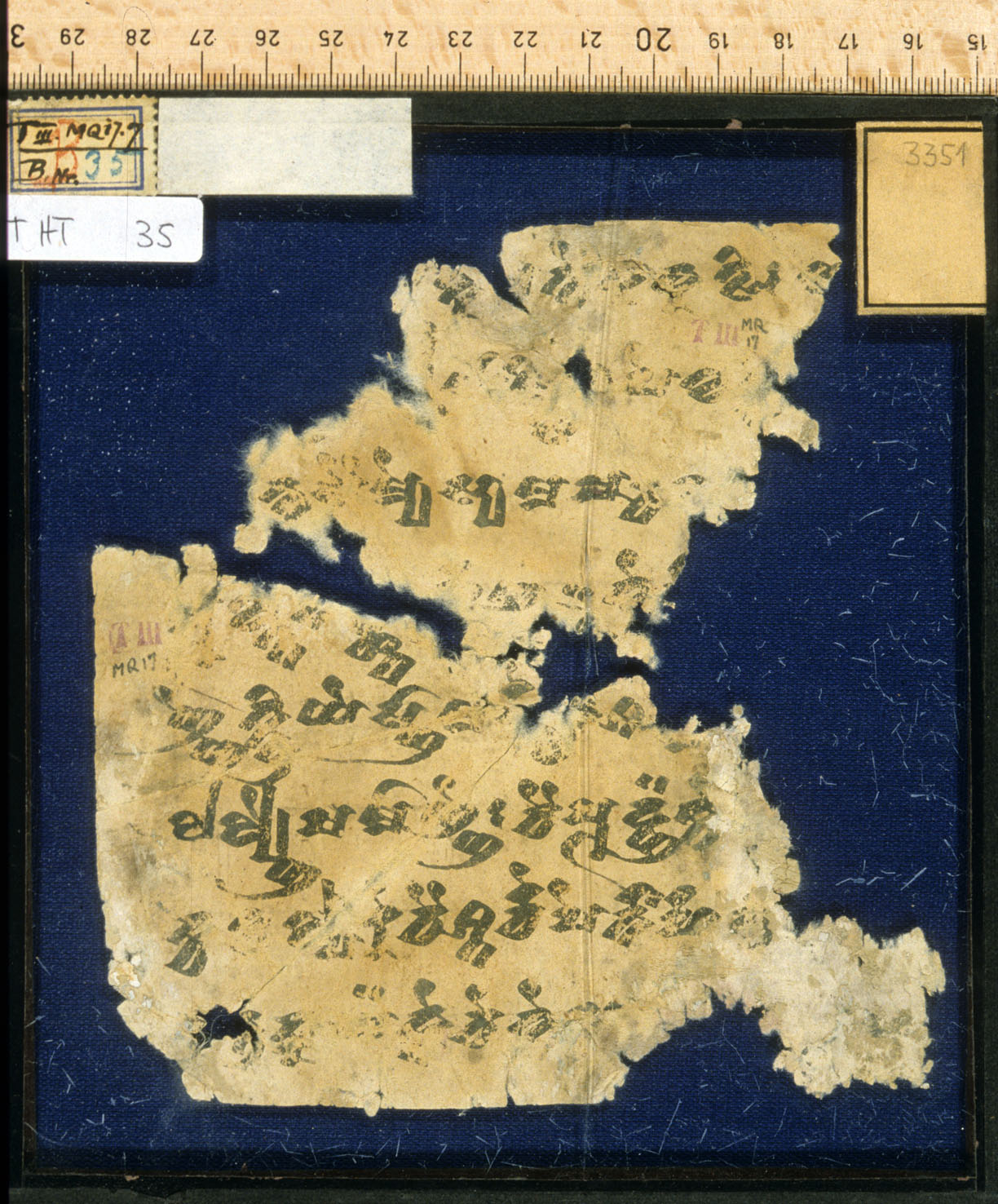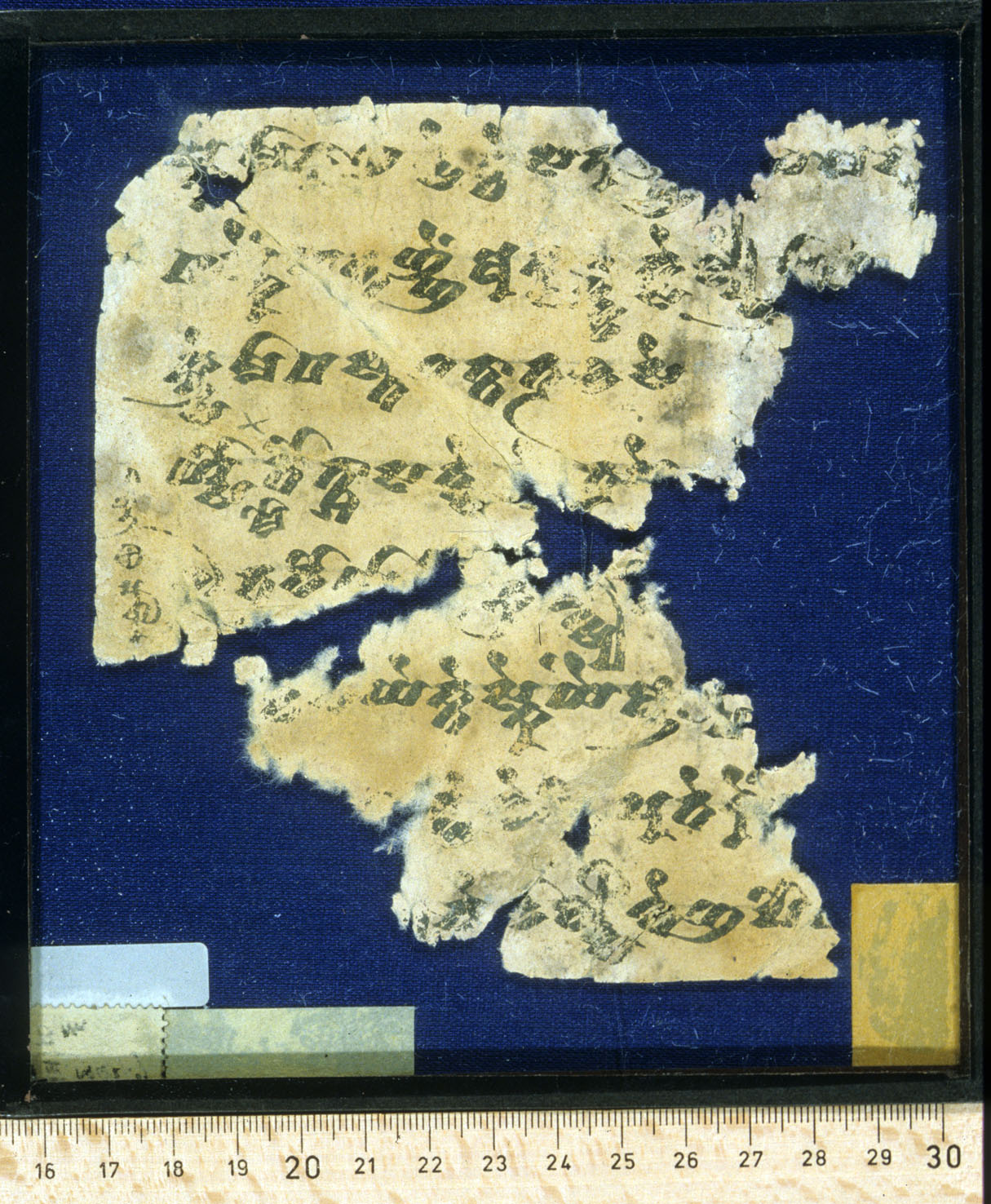THT 35
| Known as: | THT 35; B 35; Bleistiftnummer 3551 |
|---|---|
| Cite this page as: | Hannes A. Fellner. "THT 35". In A Comprehensive Edition of Tocharian Manuscripts (CEToM). Created and maintained by Melanie Malzahn, Martin Braun, Hannes A. Fellner, and Bernhard Koller. https://cetom.univie.ac.at/?m-tht35 (accessed 12 Jul. 2025). |
Edition | |
| Editor: | Hannes A. Fellner |
Provenience | |
| Main find spot: | Kizil Ming-öy |
| Expedition code: | T III MQ 17.7 |
| Collection: | Berlin Turfan Collection |
Language and Script | |
| Language: | TB |
| Linguistic stage: | classical |
| Add. linguistic characteristics: | archaic |
| Script: | classical |
Text contents | |
| Title of the work: | Udānālaṅkāra |
| Passage: | Book 14 (Drohavarga), strophes 28-34? |
| Text genre: | Literary |
| Text subgenre: | Doctrine |
| Verse/Prose: | verse |
Object | |
| Manuscript: | Udānālaṅkāra D |
| Material: | ink on paper |
| Form: | Poṭhī |
| Size (h × w): | 13.6 × 13 cm |
| Number of lines: | 8 |
Images
Images from idp.bbaw.de by courtesy of the International Dunhuang Project Berlin, the Berlin-Brandenburgische Akademie der Wissenschaften, and the Staatsbibliothek zu Berlin – Orientabteilung.
Transliteration
| a1 | – – – – tk· [m]· nte kā ka tsi : /// |
|---|---|
| a2 | – – – [l]·· yā m[t]si ·[ā] pe wa /// |
| a3 | – nta sai mye sya ma ṣa¯ ¯t /// |
| a4 | [m]ū lnta [na] [k]s̝ta [r]·· ña¯ ¯[ñ]·ä ne /// |
| a5 | ññe kwri ye sñā ma r·e [k]l· śa ·m· /// |
| a6 | la lyñe ṣa mā ññe : cai pū dñä kte /// |
| a7 | kca [ka] lpā re cai śta rce pe rnā rha [nt]· /// |
| a8 | [ma] [n]tra kk[ā] yä kne ce ne /// |
| lf | 100 90 4 |
| b1 | ṣk· mā kā ña tse cce sa nu [ñ]ñ· – ya ma [ske] /// |
| b2 | ma skeṃ [ma] nta ññeṃ a k[ā]¯ ¯lkä kse lyñe ṣ[ṣ]ā /// |
| b3 | kuse mā pa sta ta ttā tra wa se /// |
| b4 | yso mo to tśā sa ntse ··e tra ṣe /// |
| b5 | o tra no yā – kra mtsy· /// |
| b6 | – – – ye kte ske yeṃ ā [l]p· /// |
| b7 | – – – – tñe we ·i pu te reṃ /// |
| b8 | – – – – ce wā ltsi we ña po /// |
Transcription
| lf | 100-90-4 |
| Xx | a1– – – – t k· m· nte kākatsi : |
|---|---|
| Xx | /// a2– – – l·· yāmtsi ·ā pewa /// a3– nta saim yes yamaṣat /// (kuśala)a4mūlnta nakṣtär (sa)ñ añ(m) ne /// a5ññe kwri yesñ= āmar(ṣn)e kl(e)śa(n)m(a) /// a6lalyñe ṣamāññe : |
| * | cai pūdñäkte /// |
|---|---|
| a7 | kca kälpāre cai śtarce pern= ārhant(eññe) /// |
| a8 | mäntrakkā yäkne cene /// |
| b1 | ṣk· mākā ñatsecce sanuññ(e) – yamaske /// |
| b2 | mäskeṃ mäntaññeṃ akālk kselyñeṣṣ= ā /// |
| b3 | kuse mā pästa tättāträ wase /// |
| b4 | ysomo tot śāsantse ··eträ ṣe /// |
| b5 | ot rano yā – kramtsy· /// |
| b6 | – – – yekte skeyeṃ ālp· /// |
| b7 | – – – – tñe we·i putereṃ /// |
| b8 | – – – – cew āltsi weña po(yśi) /// |
Translation
| a1 | ... they fetched, to invite ... |
|---|---|
| a2 | ... to make ... |
| a3 | ... into a refuge you made ... |
| a4 | the roots of salvation. He blamed himself ... |
| a5 | if by you out of indignation (through the kleśas) ... |
| a6 | the monk's going(-from-the-house). These (of the) Buddha ... |
| a7 | they obtained the fourth level, arhathood ... |
| a8 | in such a way with these ... |
| b1 | the one being in great need they treat (with) enmity ... |
| b2 | destroy the wish for extinction ... |
| b3 | who should not abandon the poison ... |
| b4 | altogether, so much of the teaching will always perish ... |
| b5 | if he can then be hindered ... |
| b6 | ... little in efforts, if [it?] mirrors(?) |
| b7 | ... (without) anger one shall speak(?) (to) the Puteras ... little |
| b8 | ... him to keep off, spoke the Omni(scient) ... |
Other
| a4 | Er macht sich selbst schlecht ... (Schmidt 1974: 317) |
|---|---|
| b3 | Wer nicht ablegen sollte das Gift ... (Schmidt 1974: 410) |
Commentary
Philological commentary
| This leaf includes ca. strophes 28-34 of the Drohavarga (XIV) in a 4x25-syllable-metre (rhythm = 10 [or 5/5]/8/7). Strophe numbers are missing, but from the leaf count recto and verso side can be determined; this leaf immediately follows THT 34. The translation is even less secure than that of THT 34. |
Remarks
| Glass cover broken, remnant of the left side of leaf 194, damage similar to THT 34. |
Alternative linguistic/paleographic classifications
| Tamai 2011 | C3 |
| Tamai 2011 | C14 |
References
Online access
Edition
Sieg and Siegling 1949: I, 57; Sieg and Siegling 1983: 73 notes 204-205
Translations
Hackstein 1995: a4 (65), b8 (214); Schmidt 1974: a4 (19 n.4), a4 (317), b3 (410); Sieg and Siegling 1949: a1 a2 a3 a4 a5 a6 a7 a8 b1 b2 b3 b4 b5 b6 b7 b8 (II, 57); Sieg and Siegling 1983: b5 (205); Thomas 1954: b5 (724), b5 (725), b8 (721), b8 (751)
Bibliography
Hackstein, Olav. 1995. Untersuchungen zu den sigmatischen Präsensstammbildungen des Tocharischen. HS Erg.-Heft 38. Göttingen: Vandenhoeck & Ruprecht.
“The International Dunhuang Project: The Silk Road Online.” n.d. http://idp.bl.uk.
Schmidt, Klaus T. 1974. “Die Gebrauchsweisen des Mediums im Tocharischen.” PhD, Universität Göttingen.
Sieg, Emil, and Wilhelm Siegling. 1949. Tocharische Sprachreste. Sprache B, Heft 1. Die Udānālaṅkāra-Fragmente. Text, Übersetzung und Glossar. Göttingen: Vandenhoeck & Ruprecht.
Sieg, Emil, and Wilhelm Siegling. 1983. Tocharische Sprachreste. Sprache B. Teil I: Die Texte. Band 1. Fragmente Nr. 1-116 der Berliner Sammlung. Edited by Werner Thomas. Neubearbeitet und mit einem Kommentar nebst Register versehen v. Werner Thomas. Göttingen: Vandenhoeck & Ruprecht.
Tamai, Tatsushi. 2011. Paläographische Untersuchungen zum B-Tocharischen. Innsbrucker Beiträge zur Sprachwissenschaft 138. Innsbruck: Institut für Sprachen und Literaturen.
Thomas, Werner. 1954. “Die Infinitive im Tocharischen.” In Asiatica. Festschrift Friedrich Weller. Zum 65. Geburtstag, gewidmet von seinen Freunden, Kollegen und Schülern, edited by Johannes Schubert and Ulrich Schneider, 701–64. Leipzig: Harrassowitz.
Gippert, Jost, Katharina Kupfer, Christiane Schaefer, and Tatsushi Tamai. n.d. “Thesaurus Indogermanischer Text- und Sprachmaterialien (TITUS): Tocharian Manuscripts from the Berlin Turfan Collection.” http://titus.fkidg1.uni-frankfurt.de/texte/tocharic/thtframe.htm.




